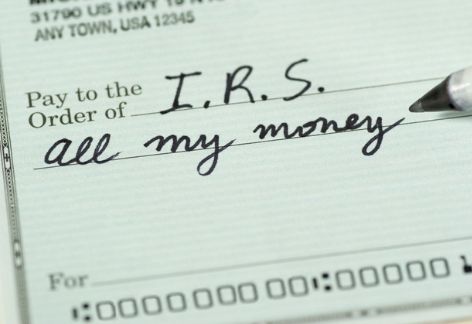Tax debt can cause significant stress, and dealing with it can be a very daunting process. Here’s how to pay back tax debt with IRS payment plans.
Tax debt is special in the most insidious way – it follows you everywhere, is almost impossible to get rid of, and can continue to grow at rates that would make most banks and financial institutions blush.
Dealing with your tax debt isn’t something you should ever put off until tomorrow, and it’s crucial to know that the sooner you commit to paying your debt, the less the IRS can do to coerce payment.
Now, we know that no one is ever stoked about seeing a notice from the IRS in their mailbox. But it’s important that you heed every single one, and pay attention to the dates. There is a system for how the IRS notifies and engages with taxpayers who are behind on their payments, and knowing when, how, and what you owe can help you get rid of your debt faster with IRS payment plans.
How Tax Debt Occurs
Maybe you made a mistake. Maybe the IRS made a mistake. At the end of the day, any time the IRS discovers that the information they received from banks and employers doesn’t match up, or if the return you filed yourself indicates that your estimated tax payments didn’t cover your entire tax liability for the year, they send in a bill for the overdue balance. It could be a few hundred dollars, or a debt of several thousand. The last thing you want to do is ignore that bill.
While the IRS automates most of the processes involved in catching and rectifying basic math errors and returns that don’t quite match up, there are still human auditors working behind their desks to process the information and make sense of the situation.
By getting in touch with a tax professional, you can work your way to an IRS agent and rectify the situation by explaining the missing numbers, or even pointing out that you did, in fact, qualify for that deduction.
If and when the IRS makes the mistake that costs you a tax debt, acting quickly and decisively can help you clear things up and get back on Uncle Sam’s good side.
But when the mistake was yours, or when an unfortunate set of circumstances led to missed deadlines and an unexpected tax debt, there are a few things you will have to know before you can set things straight.
Can I Pay Tax Debt Immediately?
Yes, provided you are up to date with your tax returns. One common source of unexpected tax debts is the missed return. Some people may have struggled with unemployment as a result of the current crisis – and they may have missed the chance to file their taxes, which is something many unemployed people must do as long as their gross income surpasses the IRS’s filing threshold.
Unfiled tax returns will flag the IRS and lead them to file a surrogate return for you, based on information returns provided by financial institutions and banks, as well as your previous tax returns. This leads to a debt and subsequent failure-to-file penalties, for five months or until your returns are sent in.
If you have a tax debt and aren’t up to date with your returns, you will not be able to negotiate an IRS payment plan to get your debt settled. If you’ve missed more than one return, it’s crucial to contact and speak to a tax professional. You may only need to send in returns for the last three to six years or recreate a return for every year you’ve missed since you’ve began missing returns, depending on your situation.
Once you’re in the clear with your basic paperwork, you can pay off your tax debt in a single payment via the IRS’s online portal. You can also write a check or payment directly to the IRS, with the instructions on the IRS’s webpage on payment plans.
If this was your first offense, and your circumstances allow it, you may be able to argue for penalty relief. This can significantly cut down on your total tax debt.
What If I Can’t Afford to Pay?
If your debt has accrued over time and grown into a substantial sum, then you might be better off trying to make multiple payments rather than a single payment.
There are two types of IRS payment plans for taxpayers unable to make a single direct transfer.
-
-
- The first is a short-term payment plan lasting no more than 180 days.
- The second is a monthly installment plan lasting longer than 180 days.
-
What If I Can’t Afford IRS Payment Plans?
You can end up paying the IRS for years, depending on what you can afford to pay per month, and the total size of your debt.
Before the Fresh Start Initiative lowered the bar for entry on alternative payment solutions, the IRS would require you to calculate whether you would be able to pay off your total debt through monthly payments before your debt expires before agreeing to reduce your total debt.
Nowadays, the IRS allows you to argue for an offer in compromise if you’re unable to pay off your debt within as few as two years.
However, making a compelling offer that the IRS will accept is still tricky, and it can take weeks for the IRS to deliberate your offer – while your debt continues to grow.
If you cannot afford to cover your debt through IRS payment plans or installment agreements, consider going through a tax professional to create an offer in compromise the IRS will accept.
What If I’m Completely Broke?
It is unethical to coerce someone to pay their tax debt if they are going through financial hardship. That is why the IRS offers taxpayers the option to declare themselves as currently not collectible. Doing so will temporarily halt all collection actions by the IRS, including liens and levies, until your financial situation improves.
What If I Refuse to Pay?
The IRS has multiple means of coercing payment and works with a select few debt collection companies to contact and talk to taxpayers about their debt.
Refusal to pay is technically illegal, but aside from the threat of a criminal charge, the IRS often uses government liens to pressure taxpayers by reducing their ability to seek financing or liquidate their assets without first satisfying their debt, and they can ultimately start levying accounts, assets, and even wages to cover a taxpayer’s tax liability.
Why You Need Professional Tax Help
You can’t get rid of tax debt by declaring bankruptcy, or by trying to hide for a decade. Getting it over with by negotiating and setting up IRS payment plans for the best possible deal is ultimately the quickest and most painless way to handle your tax debt.
However, working with the IRS can be confusing and difficult, and there are a lot of forms to fill and questions to answer on your way to total financial freedom from the IRS. Get in touch with us at Rush Tax Resolution for a free consultation, and to get a better grasp of your options.

